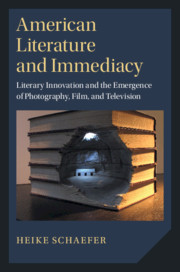 American Literature and Immediacy
American Literature and Immediacy from Part III - Literary Immediacy and Television
Published online by Cambridge University Press: 19 December 2019
The chapter defines TV’s immediacy effects. Television started out as a live medium. Although shows were soon pre-produced and recorded, an aesthetic of liveness, retained by shooting sitcoms and talk shows in front of studio audiences, has remained integral to TV culture. It sets TV apart from earlier visual media, particularly film, and is pivotal for the medium’s reality effects. Although “television” means to “see at a distance,” the initial promise of TV was that it would erase the distance between the viewers and the depicted events. Because event, transmission, and reception occur simultaneously during a live broadcast, it possesses not only temporal immediacy but also evokes a sense of spatial proximity and actuality. TV live coverage seems to bring the world home or to transport the viewers to the site of action. By presenting on- and off-screen worlds as directly connected, live TV blurs the boundary between public and private spheres, between fiction and fact, and creates the impression that the viewers participate in the broadcasted events. Since American TV is a commercial medium, the cultural dominance of TV results in a pervasive commodification of experience.
To save this book to your Kindle, first ensure [email protected] is added to your Approved Personal Document E-mail List under your Personal Document Settings on the Manage Your Content and Devices page of your Amazon account. Then enter the ‘name’ part of your Kindle email address below. Find out more about saving to your Kindle.
Note you can select to save to either the @free.kindle.com or @kindle.com variations. ‘@free.kindle.com’ emails are free but can only be saved to your device when it is connected to wi-fi. ‘@kindle.com’ emails can be delivered even when you are not connected to wi-fi, but note that service fees apply.
Find out more about the Kindle Personal Document Service.
To save content items to your account, please confirm that you agree to abide by our usage policies. If this is the first time you use this feature, you will be asked to authorise Cambridge Core to connect with your account. Find out more about saving content to Dropbox.
To save content items to your account, please confirm that you agree to abide by our usage policies. If this is the first time you use this feature, you will be asked to authorise Cambridge Core to connect with your account. Find out more about saving content to Google Drive.